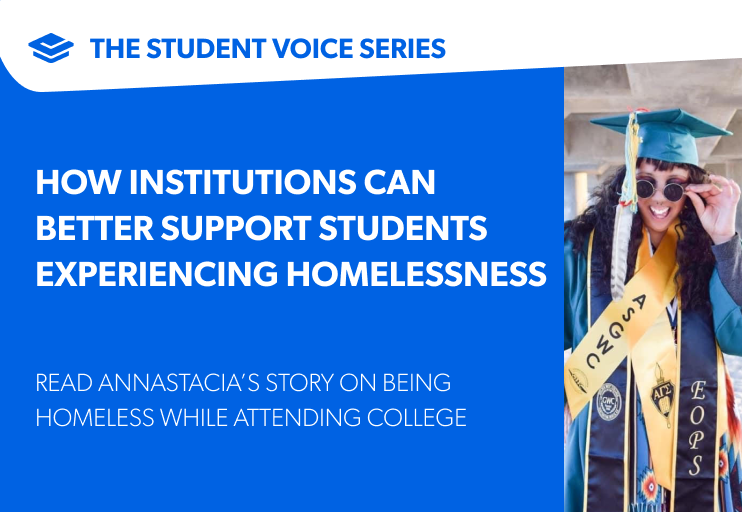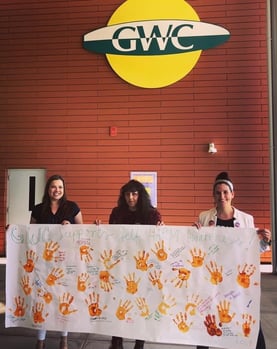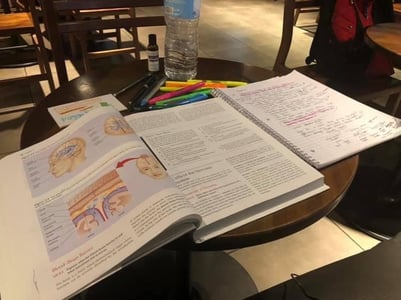The Student Voice Series: How Institutions Can Better Support Students Experiencing Homelessness
By: Annastacia Espinoza on May 23, 2022 2:45:17 PMThe Student Voice Series: How Institutions Can Better Support Students Experiencing Homelessness
By: Annastacia Espinoza on May 23, 2022 2:45:17 PM
Last Fall, Ready Education had the opportunity to connect with Annastacia Espinoza, a student from one of our partner schools who has experienced homelessness for the past two years. Her story, shared below, captures so many of the mostly unspoken challenges students in similar circumstances face.
Annastacia writes about how she was vocal on campus about her experience being homeless. In explaining her struggles with being homeless to her peers and faculty, she hoped to eliminate the stigma. It was important to her that homeless students felt accepted without feeling shame or judgment. She encourages readers to reconsider how they view and relate to the issue and offers some powerful suggestions for how higher education institutions can better support students experiencing homelessness.
Specifically, she urges administrators to eliminate “ghost resources,” resources so hard to find and so rarely talked about that it’s like they don’t exist at all.
“Many colleges and universities have resources for homeless students, and if a campus has any resources, it should be promoted to the fullest,” she writes, urging universities to find better ways to share the programs they have in place to help students experiencing homelessness.
Another suggestion is to regularly survey enrolled students to better understand how many students at their institution are currently experiencing homelessness and in need of resources. Annastacia believes this kind of data could help colleges better understand the need at their school for these kinds of programs, help universities secure more funding to support them and normalize discussion and experience of homelessness.
And finally, Annastacia’s piece makes it abundantly clear how necessary it is that universities establish trust with their students, for it is that trust that makes the difference between a student feeling comfortable reaching out for help and a student feeling alone and lost, shying away from seeking support, and eventually dropping out. She even spoke with two other students experiencing homelessness and shared that the difference between their ability to access the university’s resources came down to how comfortable and safe they felt asking for help.
To us at Ready Education, many of us who are former university administrators ourselves, Annastacia’s message reads loud and clear––higher education must find a way to reach students where they are and communicate with them to build trust from day one.
We firmly believe the right mobile solution is crucial in establishing and building these kinds of supportive relationships between students and faculty and between students and their peers. If you’re interested in learning more about how we can help your institution and your students, please reach out to us here.
Thank you, Annastacia, for sharing your story and amplifying this important issue.
If you know of a Student Voice we should highlight, please let us know by nominating them here.
Homelessness in Higher Education
By Annastacia Espinoza
Students don’t all have the support a traditional student has, and oftentimes they don’t have a home or a safe place to lay their heads at night. What is homelessness, and what does it mean to live this way? Why is there so much stigma behind it? Can you imagine being a homeless student that is terrified of being judged and looked down upon -- merely because you don't have a home? There are steps institutions can take to create an environment of acceptance and ways they can highlight the services they have available for students who face homelessness. As a student who has been homeless for two years, I come with some ideas and insight from my own experiences.
| Oftentimes, people assume that a homeless person is someone you pass by sitting on benches, walking around a parking lot, or hanging around public places with bags and blankets. A person who is homeless is a person without a home. The American Psychological Association provides this definition: “Homelessness exists when people lack safe, stable, and appropriate places to live. Sheltered and unsheltered people are homeless, people living doubled up or in overcrowded living situations, or motels because of inadequate economic resources are included in this definition, as are those living in tents, or other temporary enclosures” (American Psychological Association). Many of us put people in categories and boxes that suit our stereotypes of who we think people are based on what they are wearing, if they work, where they work, their ages, race, etc. Going to the grocery store, you pick items based on appearance and brand because you know what’s inside of them -- we need to stop treating humans like that. People are so much more than what you see on the outside. | 
Photo of Annastacia Espinoza |
When 46% of students indicate they are housing insecure, we can see homelessness is a much larger issue than many institutions may think. (The Hope Center, 2). During the pandemic, 3 in 5 students were experiencing basic needs insecurities. Now that we are in 2021, homelessness for college students has risen and expanded. Many colleges and universities were not prepared for a pandemic or even a natural disaster. Due to not being prepared, higher education institutions scrambled for resources from their districts, state chancellors, and the federal government. Some colleges were able to give out emergency stipends, and oftentimes students who really needed them were unable to receive them because only a certain number of students were selected. Being prepared to support disadvantaged students needs to be prioritized by higher education institutions. After all, many students attend college to get out of living in poverty, to better their lives. Helping make a difference in a student's life can go a long way.
 #RealCollege 2020: Five Years of Evidence on Campus Basic Needs Insecurity (Report)
#RealCollege 2020: Five Years of Evidence on Campus Basic Needs Insecurity (Report)
My Experience Being a Homeless Student Pre-pandemic to during Pandemic
|
I have been a homeless college student for almost two years. Pre-pandemic, I was on the street as I do not own a car. A typical week for me was to take out what I needed to work on for school from my storage and hang out in coffee shops until they closed. I would then go to my local Whole Foods and stay until they closed at 10 pm. Afterwards, I would take a bus to a donut shop and stay there till about 2:00 - 3:00 am, then walk about two blocks to a Norms and stay there till about 6 AM. I never slept and was a regular at both of these places. I was good at faking not being homeless and pretending to be a dedicated student who had to do work all night cause “I didn’t have time to do it during the day.” Thursdays or Fridays, I would spend hours taking buses and trains from my campus to my foster mother’s house. It was at my foster mom’s house where I would get the most sleep out of the week and eat home-cooked meals; it was where I had some normalcy. |
At a coffee shop in 2019 studying one of the many places I stayed out while homeless |
Living like this for so long while maintaining all my leadership roles and academics was very hard, but I felt I had no choice. I believe that things will always improve even if it doesn’t feel like it. When the pandemic hit, I became extremely terrified. I had nowhere to go, and I could not do my usual routine because everything was closed. I was worried I would have to drop out of school during the pandemic because I would not have access to charging devices or wifi. Luckily, I was able to get some help from my foster dad to stay in an Airbnb. Sometimes I have to leave the Airbnb because my foster dad can’t always afford to help, but I am never on the streets more than 2-3 days when this occurs.
How Golden West College Supported Me
During the pandemic, Golden West College had previous knowledge of my situation and always tried to do their best to help. They supported me in several ways:
- The EOPS/Guardian Scholars program was able to help me a few times through program funds.
- My academic advisor, Michelle Sambrano, has always gone above and beyond to ensure that I always have food.
- At one point, the Guardian Scholars program was able to get me assistance from “Together We Rise,” a program that assisted former foster youth with no age cut off.
- I was given more assistance via my college’s Financial aid director, Andrea Garcia, who is also the campus’s homeless liaison.



From left to right: The plaque I received as an executive council member for the year 2020-2021, 2021 my final graduation, February 2020 during my active minds event where I got students to show support for those who deal with self-harm. All of these images were captured while I was homeless.
Student Stories on Being Homeless
Having advocated about homelessness, I’ve met several students along the way who were open with me about their situation because I was vocal about my own. To give some insight into students' experiences with homelessness, I will share two student stories. Why one student chose to reach out for help while the other remained silent about their situation. Student A, whom we’ll call Susan, was homeless for over a year and had stated this was their second time being homeless. Student B, whom we’ll call Jerry, was homeless on and off since they were 18 years old.
Susan's Story
Susan was living outdoors, sleeping on various beaches, and at times they were able to sleep on a friend's couch, but they did not do it too often as they were embarrassed that their friends might find out they were homeless. This student told me that they chose not to reach out for help on campus because they were terrified of being judged, they felt ashamed, and were embarrassed of anyone finding out.
Jerry's Story
Jerry lived in his car, usually parking in front of a park. He did reach out to the campus for help. For him, reaching out was easy because he had a great support system at the college that built trusting relationships with the student. When you build trust with students, you make it easy for them to know who they can turn to when they begin to struggle. For Jerry, he knew who to turn to.
Susan & Jerry - A Contrasting Student Experience
Both Susan and Jerry went to the same college, yet they had entirely different experiences, even though they both were in similar situations. The difference between these students' experiences is that one was not entirely aware of the services available to them, and the other one was. Building trust and rapport with students is essential, and it can make a huge difference in a student’s life.
What institutions can do to curb the disparities in their systems
Universities and Colleges have many services, but how well are these services easy to find and/or accessible to students? In my experience, with or without a pandemic, schools need to learn how to promote and prioritize their services effectively. Especially services attached to stigmas like; disability, former foster youth, low-income services, food insecurity, homelessness, sexual abuse, violence, mental health services, and support. If a campus has a service that can serve vulnerable students -- it should be the institution's priority to make such services known to the student population.
Normalize Discussing Homelessness
Students have to dig through information to find special services on their campus. A campus that talks about homelessness helps create change within the campus’s climate. It normalizes homelessness, and the normalization of a heavily stigmatized social issue makes students feel more welcome and more prone to asking for help. Most importantly, it will encourage students to feel like it is okay to ask for help in these situations. Many colleges and universities have resources for homeless students, and if a campus has any resources, they should be promoted to the fullest.
Eliminate Ghost Resources
Do not be the college with ghost resources! Ghost resources are resources and programs that a college has to offer, but they never talk about it, so they don’t get used often. Resources for homeless students shouldn’t be a secret, and I am not saying they are, but they might as well be when they are so hard to find on many campuses.
Collaborate with Students
Another great way to help reduce the stigma and promote your resources is to regularly involve students through feedback loops and surveys. An institution can guide students in helping promote these resources and educating the campus on homelessness. Survey your students annually to gather statistics to present to your state chancellor's office to gain more funding for students dealing with homelessness. Most schools have a certain amount of funds for homeless students, but you can get more funding if you survey and present data showing that there is a need.
The power of a campus that promotes and advocates for homeless students in addition to students doing the same will lead to much-needed change and will leave a HUGE impact. This will take time and effort to see results, but it will be worth it in the end. Think of it as a building circle, a campus that thrives, and more importantly, transforms the campus into a campus that fully empowers student success. Be the change that includes students, make waves, stand tall, and do it hand in hand with your students. 


.png)
.png)
.png)

